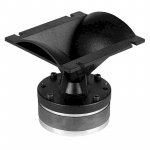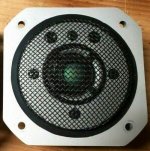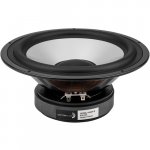No, nothing like that. I'm just noting that these things don't change when you make adjustments. On the other hand some of the driver variations do respond to adjustment so in some cases you can get two drivers to sound the same.
I'm agreeing with your initial statement that something transcends the ability to be equalised.
I'm agreeing with your initial statement that something transcends the ability to be equalised.
From my experience, flat frequency response is distant third in subjective importance, after non-harmonic and harmonic distortion. Long time ago I was also a subscriber to this speaker-building orthodoxy that flat response equals to good sound. Once I saw a tweeter on Parts Express, with exceptipnally flat response and at reasonable price. The response curve was indeed as advertized, but the tweeter was unlistenable. Then there was experience with BG Neo-8, whose response curve is horrendous, but sound quality leaves nothing to desire.
Remedies used to correct uneven frequency response, such as complex high order crossovers, are by themselves worse malady than the one they are intended to cure. Capacitors and inductors degrade the sound, with effects compounding as their numbers increase.
I think I understand what you are saying. Leaving aside the builder's skill in designing the crossovers, the careful cabinet construction (PE chamfering edges to avoid diffraction, so in fashion these days, but I fell sitting on my *** several times when I heard vintage cabinets with straight edges) and the importance of the room, what makes a cabinet sound coherent is the correct integration in the tonality of each of the transducers when they are crossed, if you want to use a horn compression tweeter, a beryllium dome midrange and an aluminum cone twoofer, there is hardly a homogeneous sound, because the crossovers could be very flat when designing the overlap frequencies according to the FR extension of each conductor, but the tonality and coloration generated by the different materials and technologies of each conductor will give a sound that is not homogeneous. An acoustic monstrosity, I would say. That's why RE speaker lovers aren't ditching their high-efficiency cabinets and SET tube amps. And they tend to be people who love good music and are used to listening to concerts.
Attachments
Last edited:
Marketing. Business needs to make profit and people buy stuff with emotion, like nostalgia for shoe boxes. Technical superiority or form follows function looks are niche within niche. Whole high end business is based on this. It doesn't take too many currency units to make technically very good speakers, rest is smoke and mirros, luxury items.
I have to mostly agree with Harbeth's philosophy regarding the importance of focusing on the midrange/midbass driver's properties first and foremost. The bulk of speaker hobbyists tend to focus on pretty enclosures with sidewalls so heavily braced that you can use them as jack stands for your car. If the driver that reproduces most of the important acoustical info is compromised in design, you end up with a lousy sounding speaker IMHO.
I'm willing to bet most of us start looking at the LF driver for its low end capabilities first (the lowest Fb in the smallest possible box) and then the midrange performance as a secondary thought when considering a new 2 way design. Its quite common to see people choose midbass drivers with favorable LF capabilities along with not so great midrange characteristics considered for use in a 2 way design mated to a small HF dome crossed excessively low and steep. You then end up with a dynamically compromised design with excessive midband THD right where your ears will bleed most along with audible ringing near the HP filter cutoff.
When shopping for a midbass driver, I always first look for a high Qms, low Le and a clean impedance trace along with a believable FR graph that has a workable on/off axis HF rolloff, so it won't need complex filtering to clean up. I then look at the cone and motor system design along with the TS parameters governing its LF properties. I'd rather build a 2.5 or 3 way design if I have to (within reason) so I can get the best useful mid band performance out of the midrange/midbass itself. Quite predictably, I tend to favor 3 way designs with dedicated midrange drivers that can cover the critical 500 Hz - 4 kHz range.
Way back in the day before having access to acoustic measurement equipment, I used pink noise and sine sweeps to design my crossovers by ear. You'd be surprised what you can come up with just using this design method. Your ears are capable of hearing very small FR fluctuations using a static sine wave sweep. Pink noise will also reveal lobing, off axis response and driver integration. Sure, its alot of trial and error and not a very efficient process requiring a big box of crossover parts, but you'd be surprised what you can do without a test setup if you have the patience and ear. After all, its your own ears you have to please. The danger here is being misled by not having a good reference built into your hearing, which can really make this a frustrating process yielding poor results. I'm fortunate to have a good ear for flat response, but nowadays I'm not as patient and rather would sim the crossover first which saves a ton of time and ear fatigue listening to test signals.
I'm willing to bet most of us start looking at the LF driver for its low end capabilities first (the lowest Fb in the smallest possible box) and then the midrange performance as a secondary thought when considering a new 2 way design. Its quite common to see people choose midbass drivers with favorable LF capabilities along with not so great midrange characteristics considered for use in a 2 way design mated to a small HF dome crossed excessively low and steep. You then end up with a dynamically compromised design with excessive midband THD right where your ears will bleed most along with audible ringing near the HP filter cutoff.
When shopping for a midbass driver, I always first look for a high Qms, low Le and a clean impedance trace along with a believable FR graph that has a workable on/off axis HF rolloff, so it won't need complex filtering to clean up. I then look at the cone and motor system design along with the TS parameters governing its LF properties. I'd rather build a 2.5 or 3 way design if I have to (within reason) so I can get the best useful mid band performance out of the midrange/midbass itself. Quite predictably, I tend to favor 3 way designs with dedicated midrange drivers that can cover the critical 500 Hz - 4 kHz range.
Way back in the day before having access to acoustic measurement equipment, I used pink noise and sine sweeps to design my crossovers by ear. You'd be surprised what you can come up with just using this design method. Your ears are capable of hearing very small FR fluctuations using a static sine wave sweep. Pink noise will also reveal lobing, off axis response and driver integration. Sure, its alot of trial and error and not a very efficient process requiring a big box of crossover parts, but you'd be surprised what you can do without a test setup if you have the patience and ear. After all, its your own ears you have to please. The danger here is being misled by not having a good reference built into your hearing, which can really make this a frustrating process yielding poor results. I'm fortunate to have a good ear for flat response, but nowadays I'm not as patient and rather would sim the crossover first which saves a ton of time and ear fatigue listening to test signals.
Perhaps some day, some brave non-arrogant member will actually post some tests of their system EQ done with their ears and how that compares to measurements before and after (that they haven't peeked at to cheat).
Of course, might be a long wait since nobody here even ever posts their hearing test.... assuming they are brave enough to get tested. A fairly trustworthy test using warble tones is:
https://hearingtest.online
I assume everybody knows why warble tones are used for this test.
Of course, might be a long wait since nobody here even ever posts their hearing test.... assuming they are brave enough to get tested. A fairly trustworthy test using warble tones is:
https://hearingtest.online
I assume everybody knows why warble tones are used for this test.
AllenB -
Very perceptive psychology. That's known as "adaptation level" - when your sensory surroundings (or stuff like neighbourhood culture) becomes your norm. Which is why folks love their systems even when installed in the most awful reverberant modern-furnished rooms. Also known in psychology as "the Burnt Soup" principle (where you like the taste of your mother's soup even if badly burnt).
While momentarily satisfying, a kookie norm doesn't hold up when "challenged" by exposure to normal environments or a kind of cross-examination from various serious-listening sessions. So just because a person is happy as could be at first as they settle in with a system, the tuning may still not hold up to listening over time.
B.
Very perceptive psychology. That's known as "adaptation level" - when your sensory surroundings (or stuff like neighbourhood culture) becomes your norm. Which is why folks love their systems even when installed in the most awful reverberant modern-furnished rooms. Also known in psychology as "the Burnt Soup" principle (where you like the taste of your mother's soup even if badly burnt).
While momentarily satisfying, a kookie norm doesn't hold up when "challenged" by exposure to normal environments or a kind of cross-examination from various serious-listening sessions. So just because a person is happy as could be at first as they settle in with a system, the tuning may still not hold up to listening over time.
B.
You state your first paragraph as if it's a law. I know plenty of audiophiles who are not happy with their system. I sure enjoy my modest system (and room) and think it punches way above its $$ but am I fully aware that it could be greatly improved? Absolutely.AllenB -
Very perceptive psychology. That's known as "adaptation level" - when your sensory surroundings (or stuff like neighbourhood culture) becomes your norm. Which is why folks love their systems even when installed in the most awful reverberant modern-furnished rooms. Also known in psychology as "the Burnt Soup" principle (where you like the taste of your mother's soup even if badly burnt).
While momentarily satisfying, a kookie norm doesn't hold up when "challenged" by exposure to normal environments or a kind of cross-examination from various serious-listening sessions. So just because a person is happy as could be at first as they settle in with a system, the tuning may still not hold up to listening over time.
B.
I'm not exactly sure what the ultimate point you're trying to make is. That ears are a completely useless tool?
And.. what is a kookie norm??
Ben, don't put words in my mouth... I know this is difficult to communicate.
If I walked into a room and someone turned on a television behind me, I'd tweak at first but I'd pay no attention. However if someone was standing in the same spot and started talkng I might turn to face them. We recognise the real thing and don't have to think about it.
If I walked into a room and someone turned on a television behind me, I'd tweak at first but I'd pay no attention. However if someone was standing in the same spot and started talkng I might turn to face them. We recognise the real thing and don't have to think about it.
Its possible to have a very accurate perception of flat FR but it takes alot of hearing training with comparative live and recorded sound sources done with calibrated mics and played back over a very good reference. This is what Harbeth has done and its the only way of claiming to have a fairly accurate ear reference. If you dont know what real live audible sources sound like, you won't be able to tell what a reasonably accurate loudspeaker sounds like, neither can you design one to sound accurate. Most people will be thrown off by their built in non linear hearing curve, which will make a laboratory flat sine wave sweep sound anything but so.Perhaps some day, some brave non-arrogant member will actually post some tests of their system EQ done with their ears and how that compares to measurements before and after (that they haven't peeked at to cheat).
Of course, might be a long wait since nobody here even ever posts their hearing test.... assuming they are brave enough to get tested. A fairly trustworthy test using warble tones is:
https://hearingtest.online
I assume everybody knows why warble tones are used for this test.
I've done alot of live acoustic recording / engineering and set up countless mid / far field monitoring systems in studios, which has really helped train my ears. I can EQ a pair of point source speakers to flat FR within +/- 1 dB from 100 - 10000 Hz in about 15÷20 min using 1/3 oct graphic EQ in conjunction with multi band parametric EQ. Its not that hard if you have done this as many times as I have professionally for the past 20 yrs. Mind you, its a whole different task to make a hifi speaker sound pleasant to the ears vs just perfectly flat. Theres also a surprising amount of leeway between flat and ear pleasing FR (ie. via help of the Fletcher Munson curve or BBC dip) and its amazing what most people can or are willing to tolerate when it comes to the far from flat FR of various production speakers. Most people won't prefer a perfectly flat sounding speaker anyways, plus there's so much more to designing a decent sounding speaker than just flat FR on its own.
Thats 100 percent correct. Its a relative comparison between the acoustic source and synthetic copy.Also, the need for a hearing test is FUD. The way things sound when I walk down the street is the way they should sound to me through a worthy system.
- Home
- Loudspeakers
- Multi-Way
- Why simple crossovers, tuned by ear, don’t work


